10 Tips and Ideas for Decorating a Large Living Room

So how can you make the best of your floor plan? We’ve put together ten design tips and ideas for decorating a large living room to help:
1. Designate zones
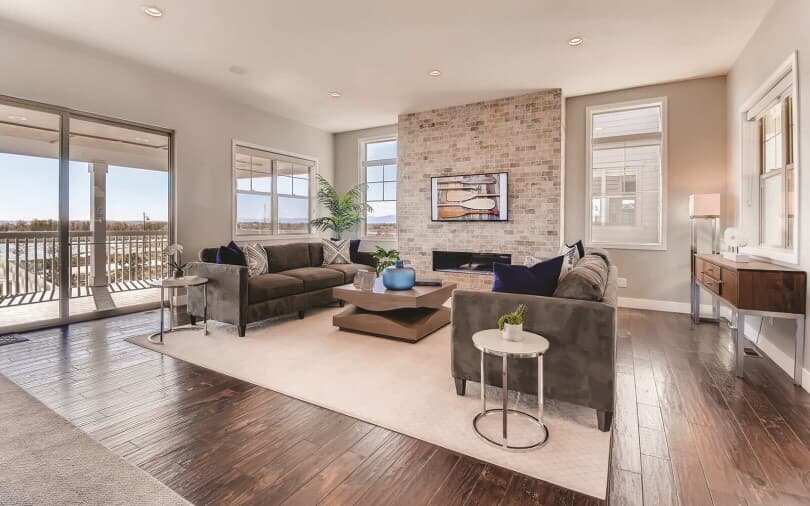
Barefoot Lakes Community, Firestone, Denver
In smaller layouts, the living room typically has space for one conversation area – and that’s it. You can’t squeeze in other furniture groupings or serve additional purposes without feeling cramped. In a larger living room, you can have a conversation zone (or two) and other areas, such as a reading nook or a workspace.
Creating multiple conversation areas in a large living room is an excellent way to break up the space and make the smaller zones feel more intimate. Using two couches creates a more sophisticated layout and invites people into the room. Try facing them toward each other with a coffee table in between, and you’ll have more seating space than most sectionals could provide. Tie your conversation areas with a cohesive color scheme and complementing design elements for a designer feel.
2. Create visual dividers
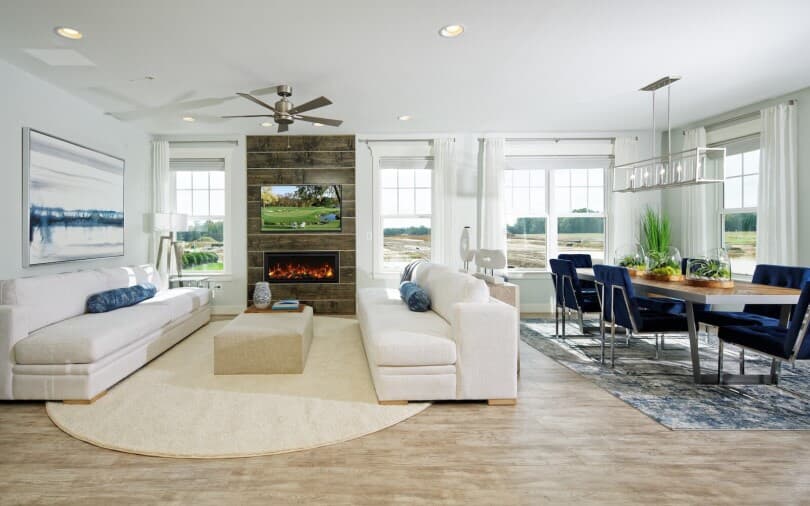
Beckner Floor Plan, Single Family Collection, Snowden Bridge Community, Stephenson, Virginia
The biggest challenge in a large space and open-concept design is the lack of separation between rooms. Creating distinctions between areas makes everything look intentional, so dividing the space according to function and giving meaning to all areas is important. A large area rug works to anchor a space and create boundaries. Furniture, such as a sofa with its back to another space, a large bench, or tables between chairs, can also be used to divide the room. Using furniture and rugs helps delineate your zones and gives each one a unique feeling.
3. Pay attention to scale
Large living rooms require large pieces. If you put too many small pieces in the room, the space will feel cluttered and incohesive. An extra-long sectional, double sofas, a large coffee table, and bulky built-ins can effectively fill the space without overpowering it.
Large living rooms usually mean lots of wall space, and these large, blank spaces can feel imposing. Some solutions include large wall art, tall bookshelves, or floor-to-ceiling curtains – anything that draws the eye upward and makes the space feel cozier. Check out our blog on Tips for Decorating a Large Wall.
4. Create a focal point
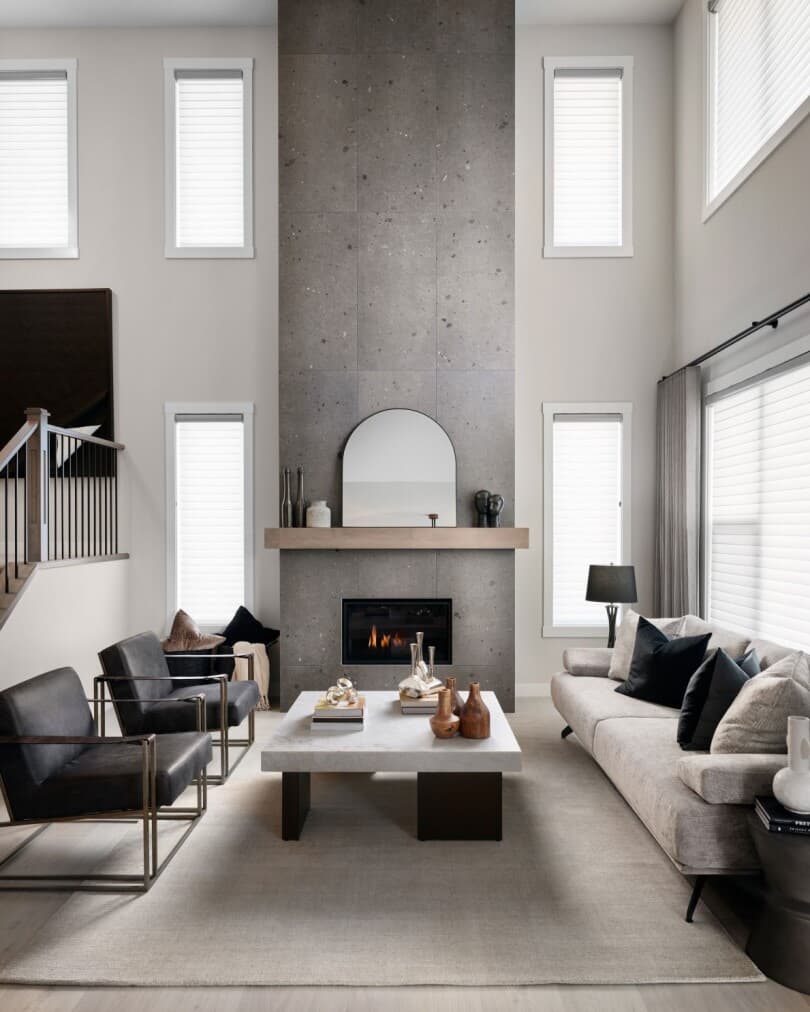
A large living room needs an eye-catching focal point. Some rooms have an obvious focal point, like a stunning fireplace or windows out to a view, but some rooms don’t. For those that don’t, the absence of something that draws the eye can emphasize the large size of the living room and make for a dull space.
Incorporate eye-catching, large-scale statement pieces like a grand chandelier, oversized artwork, or a statement wall to draw attention. A modern entertainment center is a great piece to incorporate into a large living room. You can easily hide away electronic cords, add more storage space, and display your favorite décor pieces.
5. Warm it up
Incorporating colors and patterns is a great way to break up stark expanses of space in a large living room. Making a board and batten wall and painting it a warm neutral color makes the space feel snug and cozy. If you have a high ceiling, painting it a shade or two darker than your walls highlights the height and creates a more intimate feeling.
Echoing can be a problem in large rooms. Adding layers is an instant way to cozy up a space and create an ideal acoustic environment. Layering area rugs, hanging curtains, and adding baskets provides sound absorption and softens the room.
6. Go bold

Rutgers Floor Plan, Traditional Homes Collection, Elyson Community, Katy, Texas
While smaller spaces can feel overwhelmed by bold décor, a large living room can handle over-the-top design. Bring in a statement couch, printed rug, dramatic chandelier, and decorative coffee tables for a big impact. Keep it cohesive by matching tints and tones throughout.
Artwork and accessories should also be bigger and bolder. If you’re using framed prints or photos for your walls, use larger sizes than the standard 8x10 or 5x7 frames. Group larger pieces together in a gallery wall to make an even bolder statement.
7. Layer lighting

Palermo Floor Plan, Estate Collection, Rockland Park Community, Calgary, Alberta
Any experienced designer will tell you that lighting is an essential piece of your décor, not the afterthought that so many consider it to be. Knowing the basic types of lighting and how to incorporate them in your space is a “must” in any room, even more so in a large living room. The last thing you want are creepy shadows and dark corners throwing off the vibe in the evening light.
If you have a center ceiling light, like a statement-making chandelier, you may want to add more lighting with lamps. Use two or three larger lamps with similar shades, and mix in slimmer floor and wall lamps to bring lighting to all corners of the room. This adds functionality and also contributes to the room’s overall atmosphere.
8. Bring in texture
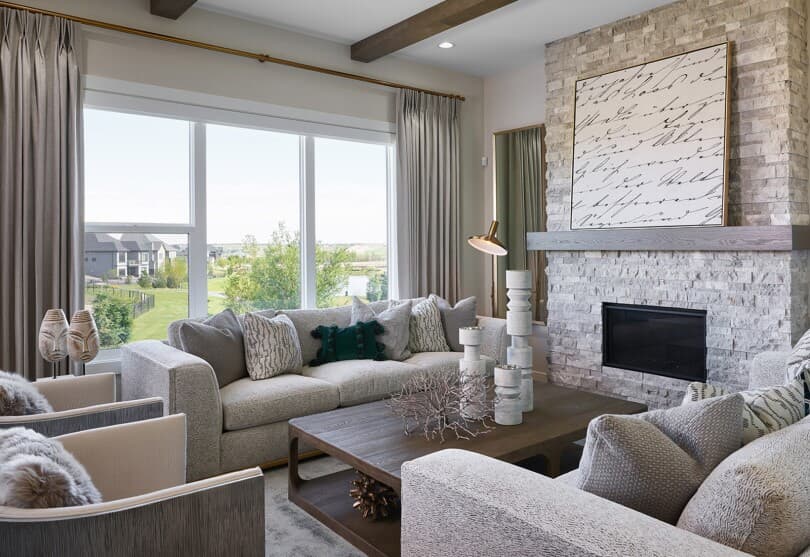
Estate Collection, Rockland Park Community, Calgary, Alberta
Introducing texture through different fabrics, materials, and décor elements adds depth and dimension to a large living room, making it feel cozier and inviting. Balancing all three elements creates a designer-approved look: décor, such as pampas grass or potted plants, paired with textiles, like curtains or pillows, and natural elements, such as wood and concrete, warm up a large space and prevent it from looking empty.
Soft and cozy accessories, like throw pillows, blankets, and floor cushions, are another great way to add warmth and comfort to the space. Bring in some color for a pop of fun, or stick to neutrals to keep the focus on the detail.
9. Add plants
Large living rooms risk feeling stark or sterile, and plants create a refreshing and calming ambiance that counteracts the potential coldness of a large room. Incorporating indoor flowering plants helps add life, color, and a touch of nature for a more welcoming feeling.
10. Avoid clutter
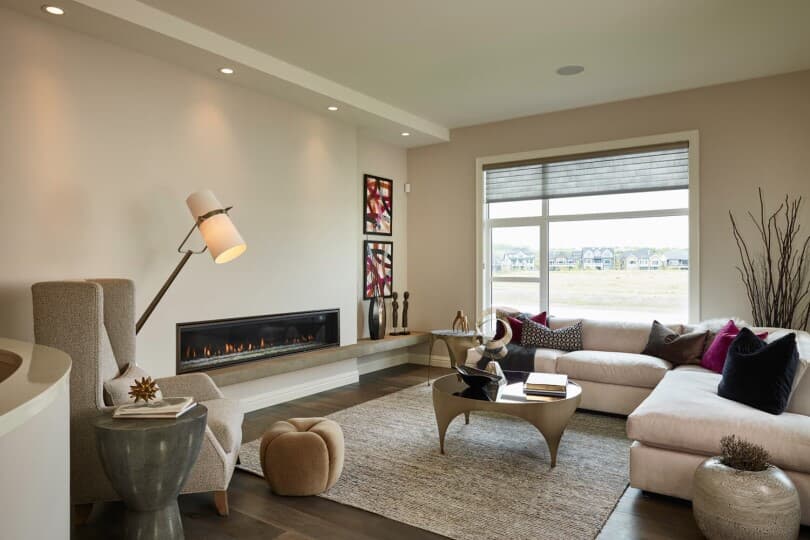
Cranston's Riverstone Community, Calgary, Alberta
There’s truth to the phrase “less is more.” Avoid overfilling a large living space with too many furniture pieces and accessories. Be intentional with the items you choose, and don’t be afraid to edit out a few.
The same is true for your furniture spacing. The key is to be generous with your spacing – even more than you would be in a smaller space. Allow for larger gaps between chairs and side tables, the sofa and coffee table, and lamps throughout the room. You’ll want to keep the tables within arm’s reach, but you have the freedom for wider passage areas between seating arrangements.
Negative space is a key feature in design. It feels simple and intentional when blank spaces are mixed with pared-down furnishings. When done correctly, the minimalist route is easy and chic (and did we mention budget-friendly?) while creating a warm and welcoming space.

Heritage Pointe Community, Calgary, Alberta
Decorating a large living room can be both exciting and challenging. By following these tips, you can create a harmonious and inviting living room that embraces its size rather than being overwhelmed by it.
Check out the Brookfield Residential blog for design advice, homebuying insights, mortgage tips, and more, including How to Arrange Furniture Like a Pro and Tips for Creating a Comfortable Guest Space. You can also explore where we build and connect with our sales team when you’re ready to learn more. We’ll be expecting you!
